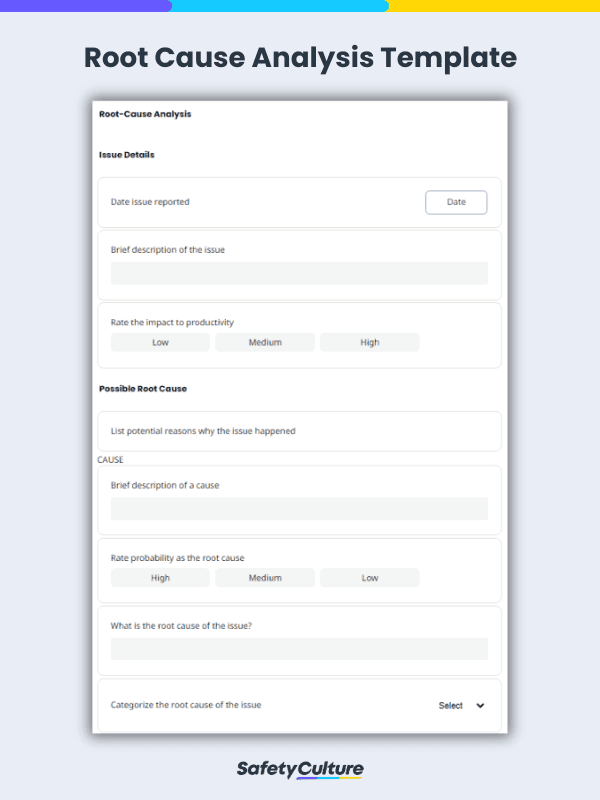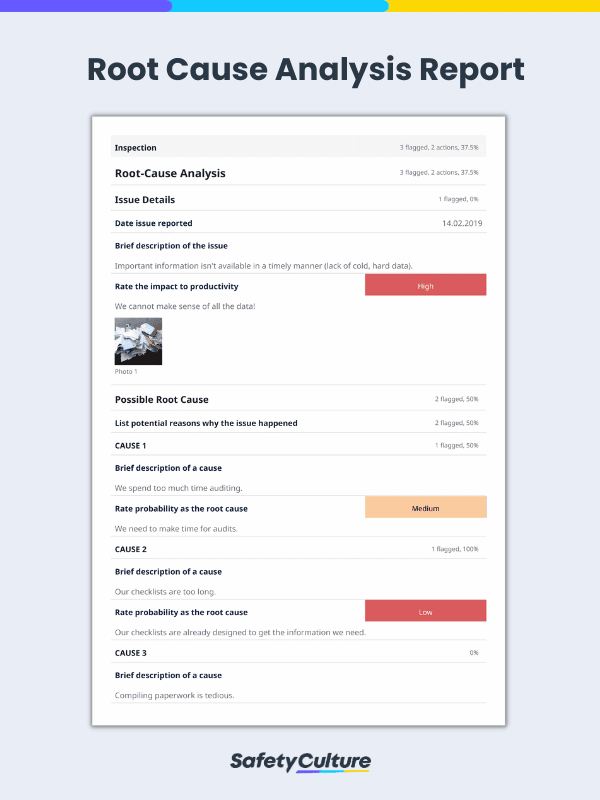What is Root Cause Analysis Template?
A root cause analysis template or an RCA template guides cross-functional teams (CFTs) in constructing a good problem statement, collecting relevant data, effectively identifying the root cause, and implementing lasting solutions. Utilizing mobile-ready root cause analysis templates can help teams take immediate action to resolve issues and cultivate a culture of collaboration and accountability.
What is Root Cause Analysis?
Root cause analysis (RCA) is a methodical approach to determining the root causes of a problem to come up with plausible solutions. Root cause analyses can help ensure the prevention of recurring problems, validating that RCA-recommended actions can improve business processes and boost productivity.
RCA Tools
Here are 4 of the best RCA tools to help you understand the organization and its context, as well as determine the right approach for your problem.
5 Whys Analysis (The Five Whys)
The 5 whys analysis is applied to universal problems across various industries due to its simple but practical nature, especially when implementing kaizen in an organization. With this root cause analysis format, pinpoint the root cause by asking, “Why did this problem occur?” five times.
Failure Modes and Effects Analysis (FMEA)
Product design and process improvement professionals perform failure modes and effects analysis to prevent costly manufacturing failures and increase customer satisfaction.
8 Disciplines of Problem-Solving (8D)
Quality engineers in the automotive industry first developed 8D for comprehensive RCAs of critical problems in the production process. Conduct an 8D root cause analysis when safety or regulatory issues have been discovered in your business and repetitive customer complaints about your product/service are received.
Six Sigma Methodology (DMAIC)
For any project that needs improvement, follow the DMAIC process (Define, Measure, Analyze, Improve, Control) and focus efforts on the analyze phase. As the most recognized Six Sigma methodology, its strength lies in the structure and rigor from quantifying the problem to implementing long-term solutions.
How to Write a Root Cause Analysis in 5 Steps
The root cause analysis can be done in a few simple steps which are as follows:

- Define the problem – This first step aims to recognize any issues, problems, or areas for improvement in any specific unit of the business or organization.
- Collect data – Gather evidence or relevant documentation that supports and investigates the elements involved in the identified problem.
- Determine possible causes – List events or situations that may be contributing factors to the cause of the problem.
- Identify the root cause – Using various tools and problem-solving methods available, specify the root cause of the problem.
- Implement solutions – Recommend and enforce possible solutions or preventive measures that would lessen, if not eliminate the problem or the root cause.
Learn more about how to comprehensively do the root cause analysis with a ready-to-use RCA template.
What to Include in a Root Cause Analysis Template
Below are elements that you can consider for your root cause analysis to ensure all relevant details are well-accounted for in your form:
- Title Page – Include the basic details of your analysis session such as the date and location, as well as the name of the facilitator for proper documentation.
- Issue Details – Use a section of your RCA template to document the date the issue was reported, its brief description, and the rating of its impact on organizational or employee productivity.
- Possible Root Cause – List the potential reasons it happened, the main category of the issue and the identified or potential root cause of the issue.
- Next Steps/Recommendations – An RCA template must also include a section that lists the solution to be implemented, the estimated cost, and if there are special considerations or findings to be reviewed for corrective action.
- Completion/Sign-off – Put the details of the RCA team, as well as the full name and signature of the facilitator or person-in-charge (PIC).
RCA Report
To give a more detailed overview, below is an example of a completed Root Cause Analysis Report.
Root Cause Analysis Examples
To offer further insight into how this tool can be applied by organizations, below are real-life examples of implementing root cause analysis in the manufacturing and construction industry:
Root Cause Analysis Example in Manufacturing
Problem: Innovative Ideas Corporation, a leading producer of raw materials for electronic gadgets, experienced an oil spill on the loading dock. This has rendered a portion of the dock inaccessible and poses a serious risk to the safety of workers and vehicles maneuvering in the area.
Sawyer James Loren, the on-site safety personnel was immediately dispatched to look into the issue and identify what caused the spill. He deemed it best to use the 5 Why’s method for this analysis.
- Why – The forklift is leaking oil
- Why – The gasket dried out
- Why – It was a cheap aftermarket gasket
- Why – We saved extra money by buying cheaper, aftermarket gaskets in bulk
- Why – The procurement department is incentivized to save money and not safety
Is the root cause of the problem identified? Yes.
While performing the RCA and working through the 5 Whys, the management also implemented countermeasures to mitigate short-term risks while implementing corrective and preventive actions at the root cause level.
- Countermeasure – Clean up the oil spill
- Countermeasure – Replace the gasket
- Countermeasure – Pull the current stock of aftermarket gaskets
- Countermeasure – Order OEM gaskets
- Countermeasure – Realign the incentive program with safety
Root Cause Analysis Example in Construction
Problem: A backhoe operator at a busy construction site struck an unmarked underground utility line while maneuvering the equipment, causing a loud noise and prompting an immediate halt. The project manager was notified, and the 5 Whys method was used to investigate:
- Why was the line hit? – It wasn’t marked.
- Why wasn’t it marked? – The records were outdated, and the line wasn’t on the print.
- Why were the records outdated? – The company that performed recent work failed to submit updated facility records.
- Why didn’t they submit records on time? – Their process is flawed, and the utility company didn’t catch the issue.
- Why didn’t the utility company catch it? – Poor collaboration between operations and the records department.
After identifying the root cause, the project manager emphasized to both parties the critical need to maintain updated records to prevent safety hazards.
FAQs About Root Cause Analysis
RCA or root cause analysis is performed when an incident occurs and it results in an undesired outcome. An RCA is performed to help businesses determine and document the potential cause of that incident and create countermeasures to prevent its recurrence.
A root cause analysis is conducted by a small team. The team is composed of experienced personnel involved in the business process/area where the issue occurred.




